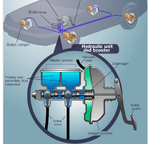
- Joined
- Jan 22, 2008
- Messages
- 53,713
- Helped
- 14,812
- Reputation
- 29,921
- Reaction score
- 14,446
- Trophy points
- 1,393
- Location
- Bochum, Germany
- Activity points
- 303,666
Your simulation also shows that an OP without bandwidth limitation isn't stable in closed loop operation. If you change the slew rate limitation to a simple first order low pass, the permanent oscillation will disappear.




